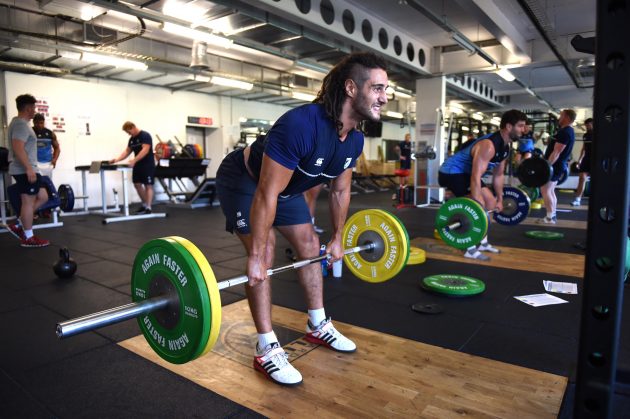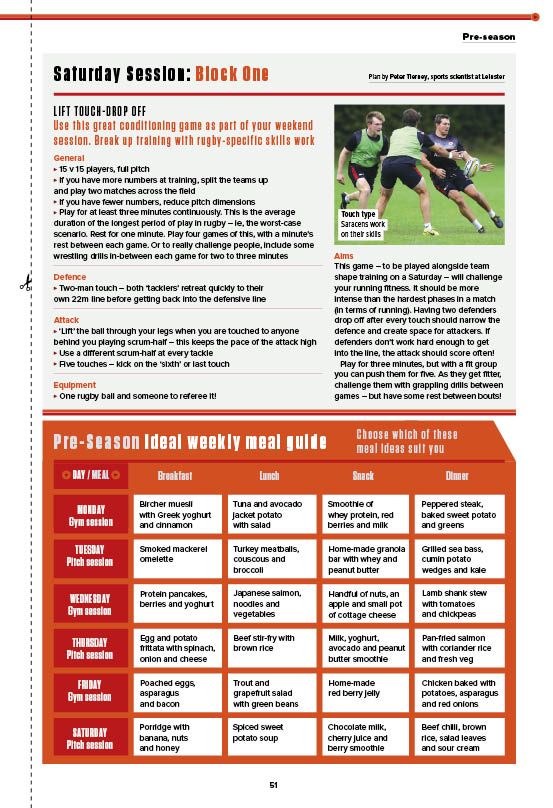Rugby World enlists some fitness-focused stars – including co-author Josh Navidi – to get you in top shape for the new season
Rugby Pre-Season Guide: Part One
W HEN ASKED to concoct the dream pre-season for a fictional amateur side, Cardiff Blues and Wales flanker Josh Navidi laughs. “The dream pre-season is no pre-season!” he says.
We know what he means. Anyone who has dragged their backside through a summer regime is familiar with the low-level dread you feel before heading out on the field; it’s more vampire bats than butterflies flapping around in your stomach.
However, having asked around we concluded that Old Tatooineans – our fictional side – would best benefit from a pre-season split into two blocks of three weeks of graft, before any friendly matches are played, with a week off between the two blocks.
There is running, you can’t escape that. Contact on the hard ground is in there too. But we’ve done our best to mix things up, offering variety and reasoning. Over the following pages, we have the outline of a basic weights programme, an idiot’s guide to eating while you train, plus tips from the pros and two brutal session plans you take to your club. Enjoy!

Lifting standards: Our co-author, Josh Navidi of Cardiff Blues and Wales
Block One
“With the Cardiff Blues, we normally have the first two weeks doing weights and a bit of skills,” says Navidi, now Old Tatooineans’ head of strength and conditioning. “Then you build up to more rugby specifics. Normally we don’t go straight in and do rugby.
“So if we build gradually it’ll be fine…”
What this means is that our team will take part in two blocks of training, with the first one focusing on conditioning and skills, with a little bit of team shape. Block two introduces a lot more rugby.
With block one, ‘gradual’ means starting in one place: the bear pit of the gym. We expect our players to hit the gym a minimum of two times a week, but we would hope it’s three times – see our basic plans top right. We’d also love our team to train on Tuesday and Thursday nights, with on-field work as a squad on a Saturday morning (more on that on pages 51 and 52).
Navidi – a qualified personal trainer, as well as an all-action back-rower – wrote our gym plan. We’ve approached this as if you have very little experience in the gym – we want you to build a base, so for a few months at least, it’ll be tough. We want you to put on some muscle.
On the field, during the first few weeks of pre-season, you only have a short period of time with the team. “I’m massive on having anaerobic games, simple touch games,” Navidi says of
his ideal session.
“We do a three-minute block, then we’ll go into rugby or a specific skills session that’s still quite high in intensity. When I’ve tried it with young players, the standard drops after two minutes. You want to keep the intensity. So do two minutes at first.”

Wrestlers: Leinster go at each other in training
We can’t tell you what to do for every minute of your sessions – coaches have to be flexible and clear on their plan. However, Old Tatooineans get a mix in the opening fortnight. The basic outline of our Tuesday training is touch games, split up with basic skills work for backs and forwards. Coaches will decide how often you shuttle between them, depending how fit they want you and the time they want to dedicate to skills.
In terms of the Tuesday touch games, play different formats for two minutes at a time – offside touch (pass backwards after first touch, then you can pass forward) or Fijian touch (if touched once, offload; touched twice, put the ball through your legs).
Between these games you can throw in basic skills. With players relatively new to rugby, you might implement static passing, then progress to passing along a line, jogging in fours. This is when we will split, forwards and backs.
The backs will work on basic running patterns, passing and kicking skills, in line with the coach’s vision for the team. The pack can work on their lineout. This will be the basics of lifting and jumping in the lineout at first. This means trying lifting pods and working on the throw.
This can progress to setting out different-coloured cones so that you work on getting the lifters and jumpers to move. At the end you can turn it into a competition with pods jumping against each other, adding an element of fun.
The sting in the tail of Tuesday’s session comes from Navidi. “We do aerobic interval running. It’s very simple – 15 seconds running, 15 seconds off. It’s about how far you can go. You can tailor it. If you start on the try-line, our back-rowers normally hit the far 22. So get everyone on the line and put a cone down as a target for each position, one for front-rows, one for the locks etc.”
He suggests doing a set of five runs, rest, then go back for a final set of five.On the Thursday session Navidi wants a similar set-up but with more intensity. However, the skills you concentrate on must change to keep it fresh. For example, your touch games can reflect a skill you want to focus on, like a touched player hitting the ground and working on ball-presentation skills. Or introduce pared-down defensive drills, purely looking at a chain of players rushing up and communicating.
At the end of Thursday’s session, do away with the runs and work in an old-school circuit. No equipment is really needed. Partner up. Aim for a work:rest ratio of one:one, doing 30 seconds of an exercise and having 30 seconds off for your partner to do the exercise before quickly moving to the next exercise. Or do this for 15 seconds each and complete the circuit twice. Navidi would have players wrestling, doing short sprint shuttles, wheelbarrows and burpees, and then jumping laterally over a hurdle, cone or pitch marking.

Lineout time: Auckland Blues during pre-season
In week two, on the field there is a similar feel. But Navidi wants a slight increase in time spent on games. It ramps up again in week three, with more time spent on games and added reps for fitness.
In the gym, true beginners should stick with the plan (P49). For more advanced lifters, increase weight and drop some reps to develop strength. Then shift the focus on day one and two to how quickly you move moderate weight (70-80% of your top weight) for power.
Navidi has a plan to take you towards the break with a clearer team identity.
“When you have forwards and backs split, you should use the lineout calls as well as backs moves,” he says. “Try it at the start of the session. It’s low in intensity. Do it for 20 minutes, then come together for team structure. Then go into blocks of games and running, come back, do it again. Repeat this as often as your coach feels necessary, depending on how fit you want to get.
“Thursday of week three you want more intensity. Do what you worked on on Tuesday but as a team. Run to different areas of the field, building in ‘lineout here’. Do up to five phases, then go ‘scrum here’.
“You are going for fatigue then into games, then back into rugby. Finish with sprints from the halfway. Look for speed and power, not fitness.”
Oh, and about Saturdays…

For part two of our pre-season guide click here.





